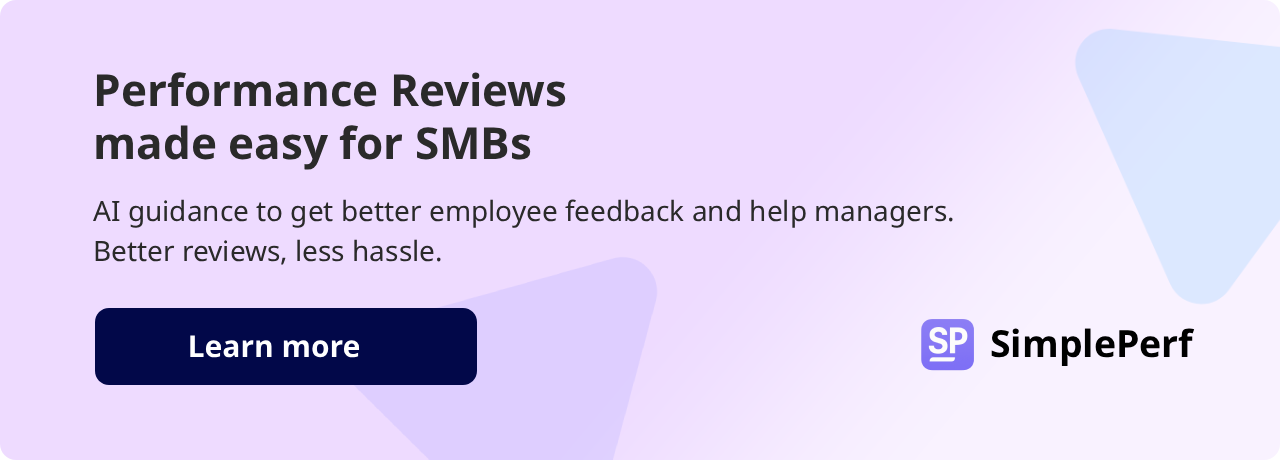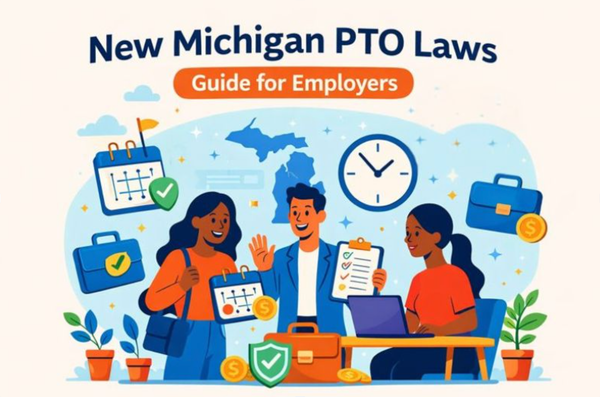8 Common mistakes employers make in performance reviews and how to avoid them
Avoid common performance review pitfalls with our guide to 8 employer mistakes—and learn how to run fair, consistent, and effective evaluations.

Employee performance reviews are tricky. They can either go very well or really badly. The outcome depends on the amount of preparation you do beforehand, the concrete data you collect, and your ability to give constructive feedback.
Join us as we discuss mistakes employers make in performance reviews and how to avoid them, because once you know where things go wrong, you can only do better. Since the performance evaluation is a key component of keeping your employees engaged, focused, and satisfied, it's probably a good idea to master this process.
Key takeaway: Avoiding common review mistakes will help you run productive, meaningful, and forward-thinking annual performance reviews that will not only keep your employees engaged, but also your business on track.

Mistakes to avoid when doing performance reviews
The most common mistakes made by employers during the review cycle are insufficient preparation, not collecting supporting evidence, being inconsistent when giving constructive feedback, performance bias based on personality, and failing to track progress.
However, others focus solely on negative feedback, vague expectations, and an inability to have difficult conversations.
1. Not doing enough prep before the review process
Honestly, avoiding this first mistake will likely prevent most of the other mistakes. This is where the nuts and bolts of your performance management system come together, making it easier to understand before you speak to your employee.
During preparation you have the opportunity to:
- Schedule a review appointment, giving both yourself and your employee enough time to gather information.
- Gather concrete evidence that supports or refutes ideas you have about the employee's performance.
- Think about both positive feedback and constructive criticism you can provide in light of the performance evidence.
- Write down some actionable steps you would like to see the employee take during the next review period.
- Prepare yourself mentally for difficult conversations.
Yes, preparation can be time consuming. We won’t deny that. However, many performance review software programs now exist that can pull all the elements of the review process together for you, allowing you to concentrate on giving feedback.
2. Not collecting evidence to prove your assertions
This important step of the performance review doesn’t get enough respect, and the result is dissatisfied employees who cannot understand the feedback they’ve received.
Any assertions made by an employer need to be based on something more than recent interactions with the employee (recency bias), or favoritism, or opinion. Even the legal system works like this. Everyone is presumed innocent until proven guilty, based on evidence. However, in the workplace biased feedback often seems like the norm.
You can avoid this mistake by collecting actual performance data according to set criteria (such as a KPI rating system), conducting assessments like the 360-degree assessment, and other peer-to-peer feedback.
When the evaluation calls for subjective measures to be taken into account, such as the employee’s response to company values and teamwork, you can easily set up employee engagement apps that track this data over time. One such app is from BuddiesHR. Clappy Kudos facilitates recognition amongst peers, and provides you with ongoing data for reviews.
3. Lack of consistency when discussing individual performance
This mistake can easily be avoided. It stems from a lack of preparation and the belief that effective performance reviews require you to adapt your approach to suit each employee.
For example, you strictly prepare for difficult performance reviews, but conduct an informal, rushed conversation with a consistent performer (or none at all). This causes one employee to feel like they’re on a bed of nails, and leaves the other one unappreciated even though they’re performing.
By having one process for all employees, you will increase employee engagement and get valuable feedback from each staff member, which can help you craft highly effective business strategies. In everyday life, we also tend to neglect what is already working and focus on what isn’t, but it won’t be long before your top performer runs out of patience and steam, when their need for feedback isn't met.
4. Performance bias based on personality of the employee
For most employees, an employer that recognizes performance based on favoritism is the worst case scenario, and makes for a toxic work environment. Yes, we all have our likes and dislikes. That’s unavoidable - even in the workplace. However, when it comes to performance feedback the whole process shouldn’t be about personality.
Brené Brown notes in her recent Netflix special, The Call to Courage, that it’s not so much whether you have bias, but how much it affects your judgment. The truth is that personality and likes can affect our judgment a lot. So, how can this mistake be avoided?
Forbes suggests that recognizing your bias is a good start, followed by implementing regular check-ins (so that you respond to performance and not long-term likability), and fighting bias with data.
5. Failing to follow up (track progress)
Setting SMART goals is a key objective of a performance review.
Employees want to leave the discussion understanding exactly how they should improve performance before the next review, and they want you to commit to your follow-ups with them.
Now we know that everyone gets caught up in the grind, and routinely tracking performance progress may feel like a mountain to climb. But we’ve recognized that managers who feel like this are the ones being crushed by the weight of mundane admin tasks that can easily be automated by performance review software like Simpleperf, by BuddiesHR.
This software will facilitate the collection of performance evidence and assessments, and schedule review appointments and follow-ups, making sure you don’t have to. Now you’ll have plenty of time to track progress and conduct great performance reviews.

6. A focus on negative feedback
The nature of performance discussions will require you to give some negative feedback. However, the best reviews focus on a good balance between constructive criticism and positive feedback. Sometimes this can be difficult, especially when you are not in a good mood, or when the employee hasn’t been meeting performance expectations.
Using a performance improvement model like the GROW coaching model will help you to avoid this mistake. This model helps you to remove internal blocks that hinder performance, but it stays focused on using what the employee already knows and can do, instead of adding additional skills. It encourages active listening, asking in-depth questions, and facilitation instead of fixing.
7. Communicating vague expectations
Vague expectations lead to a lack of accountability in organizations because employees don’t know what they should be doing to perform.
While keeping things open-ended may seem like a good strategy in today’s ever-changing marketplace, but this approach can be detrimental to the ultimate success of your business.
Mike Mooney, a former Motorsports executive and keynote speaker, noted that vague expectations kill performance, and leaders are often the cause. He further suggested “Clear as mud” expectations lead to confusion, blame, and mediocrity. His advice is that expectations should be laser clear and communicated as simply as you can without diluting the message.
8. Inability to successfully navigate difficult conversations
This mistake is often made purely because it's uncomfortable and unpleasant. It's not something any employer enjoys and rather than make things worse, conflict is avoided. However, in the long run, avoidance will cause damaged relationships, poor performance, or low employee engagement.
A University of Minnesota resource suggests you take the following steps:
- Prepare adequately, making sure you have the facts.
- Anticipate negative emotions.
- Establish a conversation objectively.
- Give very specific feedback based on evidence.
- Listen to understand and help.
- Work on next steps together with the employee.
Avoid common performance review mistakes and change the way your run review cycles
Our discussion has centered around eight common mistakes employers make in performance reviews and how to avoid them.
We’ve shown that ignorantly making these mistakes can lead to unwanted consequences for your business and employee engagement, which is not in your best interests. However, armed with the power of increased knowledge, you can run great reviews.
We would also like to show you how the BuddiesHR employee engagement apps can increase the effectiveness of your entire review process, often sorting out many of the mistakes before they occur, and therefore setting you up for success in the simplest way possible.
👉 Yes, I’m ready to run great performance reviews right now





